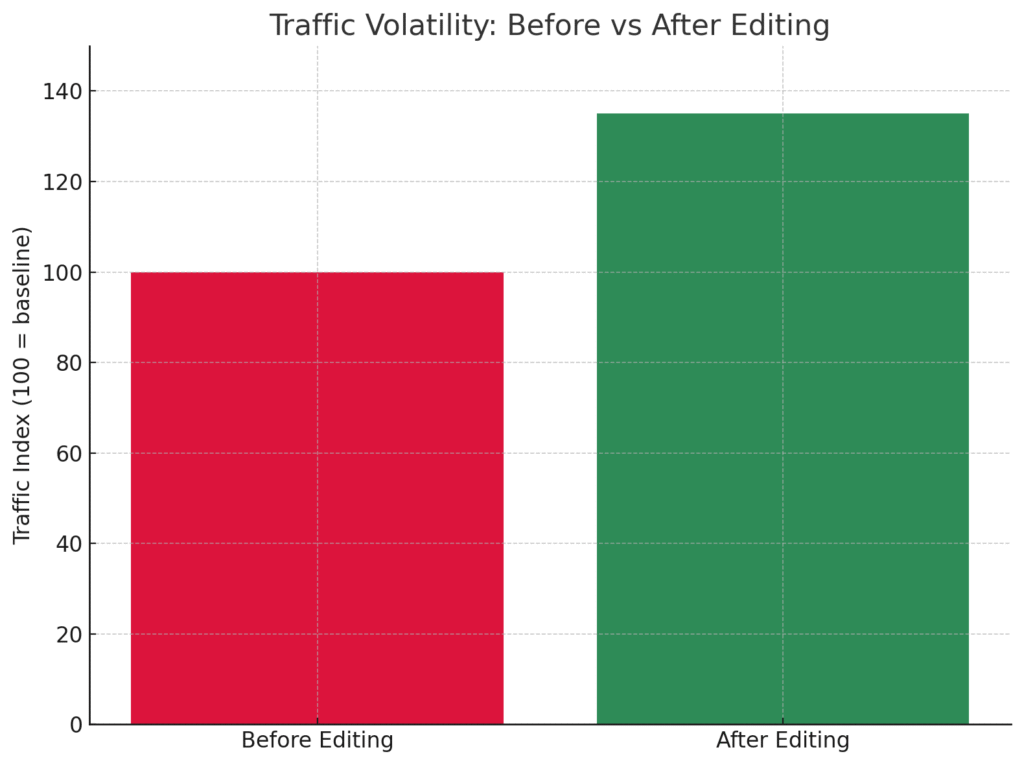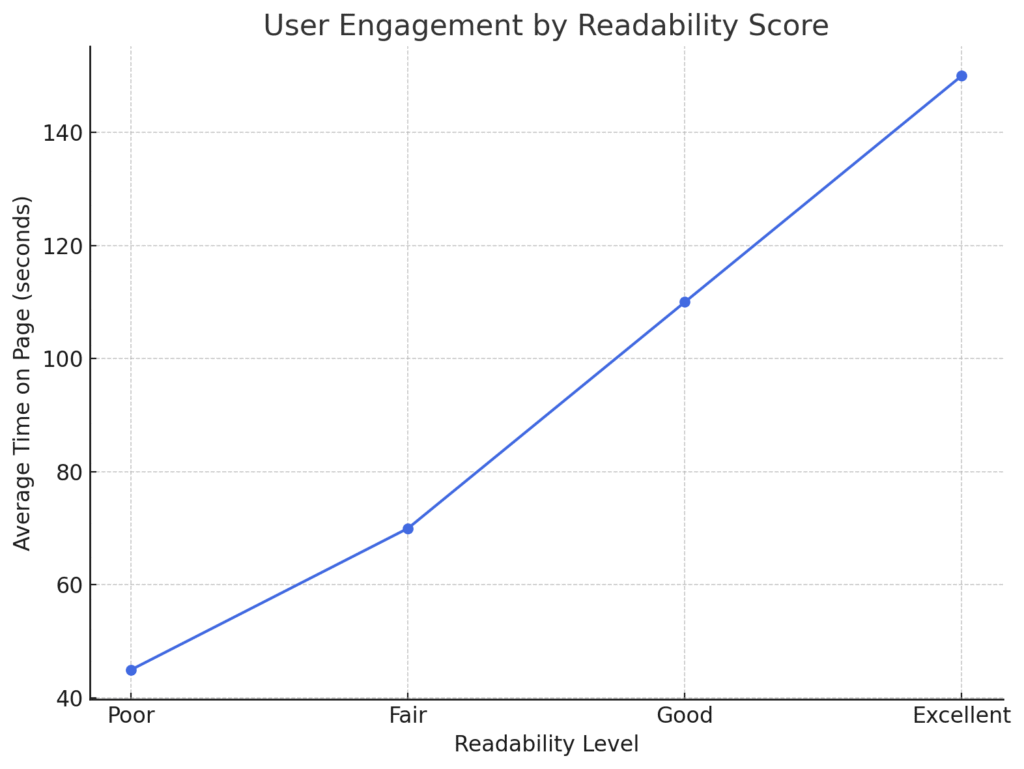SEO Optimization in 2025: Why Content Alone Isn’t Enough (And How Smarter Editing Wins)
SEO has always been a moving target. What worked five years ago doesn’t work today. What works today might not work tomorrow.
In 2025 the rules of the game have changed again. Google’s March Core Update and the August Spam Update shook the foundations of SEO across the USA and UK. Sites that relied on bulk content strategies, generic AI drafts, and keyword stuffing strategies fell sharply. Overnight traffic declines became the new normal for publishers who had ignored the signals.
If you care about ranking, visibility, and organic growth, you need to recognize this shift: content alone is no longer enough.
SEO optimization today requires more than writing. It requires editing. It requires auditing. It requires aligning your content with trust, clarity, readability, and structure. Without that, your content doesn’t just underperform. It disappears.
This article is not about panic. It’s about perspective. I will show you why SEO optimization has become harder, why editing is the missing link in most strategies, and how a modern content editor tool solves the problem.

Why SEO Optimization Is Harder Than Ever
There was a time when SEO was almost formulaic. You found keywords, you stuffed them into a blog, you built some backlinks, and you waited for rankings.
That world is gone.
Today three powerful forces have made optimization harder and more complex than ever:
1. AI Overviews and Zero-Click Searches
Google and Bing have rolled out AI summaries, sometimes called AI Overviews or answer boxes. These give users answers on the results page itself. Many users never click through.
That means ranking on page one isn’t enough anymore. Your content has to be structured, quotable, and clear enough to be pulled into those summaries. If it isn’t, you miss visibility entirely.
2. Tougher Quality Standards
Google’s Search Quality Rater Guidelines, updated in 2025, highlight originality, trust, and experience. Content that looks generic, thin, or machine-produced without oversight is penalized.
The August Spam Update made this real. Sites in the UK and USA that had been publishing large volumes of generic AI content saw sudden traffic drops.
The lesson is obvious: if your content doesn’t add value, it doesn’t survive.
3. User Behavior
Users are impatient. They want fast, clear answers. They want trust signals: author names, sources, data. They want to scan and get value quickly.
Walls of text without structure lead to bounces. And bounce rates feed back into how Google sees your quality.
Why Most Brands Are Struggling
Even as the landscape has shifted, many businesses are stuck in the old playbook.
Here’s what that looks like:
- Publishing volume over quality. Teams push out dozens of posts but few that add new insight.
- Keyword focus without semantic context. Writers target a single keyword but ignore related terms, questions, or topical breadth.
- Editing as afterthought. Editors check grammar and spelling, but not readability, clarity, trust, or search intent.
- AI over-reliance. Drafts generated in bulk and published with minimal human oversight.
This creates content that looks fine on the surface but fails under scrutiny. Google notices. Users notice. Rankings suffer.
The harsh truth is that most content strategies break not at the writing stage, but at the editing stage.
Editing: The Missing Link in SEO Optimization
The word “editing” sounds simple. Many assume it means grammar and typos. But in SEO, editing is where optimization actually happens.
Here’s what true SEO editing means:
- Structure: Breaking content into clear headings, FAQs, and lists so it’s machine-readable and snippet-ready.
- Clarity: Ensuring the core answer is near the top, not buried paragraphs down.
- Depth: Adding context, sources, and examples so content feels complete, not generic.
- Trust: Including author bios, credentials, and citations. Signals that content is credible.
- Readability: Shorter sentences, active voice, clear flow. Users should enjoy reading, not fight through it.
- Semantic coverage: Using related terms, variations, and questions to capture broader search intent.
If your editing doesn’t cover these, your content will struggle in 2025.
Why Tools Matter: Humans + Data
Editing by instinct is not enough. You cannot manually compare every draft to competitors, check readability across 50 pages, and audit semantic coverage.
That’s where tools step in.
A modern SEO content editor tool acts as leverage. It gives editors the data and guidance to transform an ordinary draft into content that performs.
It does not replace the human. It empowers the human.
With the right tool you can:
- Compare your draft against top competitors for gaps in structure or depth.
- Identify missing subtopics or questions people are actually asking.
- Get readability scores that predict user engagement.
- Flag missing trust elements like sources, citations, or author info.
- Ensure semantic coverage so you capture not just one keyword, but the full intent.
This is the difference between content that looks fine to the writer and content that Google rewards.
One such solution is the AI Content Editor Tool. Positioned as an alternative to Surfer SEO and NeuronWriter, it helps you align drafts with what search engines and users expect today.
Real-World Example: How Editing Saved a Site
Let’s ground this in reality.
A US tech blog had been publishing reviews and comparisons. Traffic was solid but plateaued. Then the March Core Update hit. Traffic fell 25% in a month.
Why?
The audits revealed the problems:
- Reviews reused manufacturer descriptions with little original insight.
- No author bios or credentials.
- Long paragraphs with few headings.
- No FAQ sections.
- Outdated stats.
They didn’t stop publishing. They changed how they edited.
Using a modern content editor, they restructured articles. They added FAQs. They broke paragraphs into short, scannable sections. They updated numbers, added citations, and wrote bios for each reviewer.
Within two months, traffic rebounded. Several posts began appearing in snippets and AI overviews. Engagement metrics improved: bounce rates dropped, time on page rose.
The writing didn’t change much. The editing did.
What You Should Do Now: A Practical Audit
If you want to protect and grow your traffic, start with an audit. Pick your most important 10 pages and ask:
- Is the answer clear at the top?
- Are headings structured logically?
- Does the page include FAQs or common questions?
- Are there citations and sources?
- Is the content updated with 2025 data?
- Does it read smoothly for humans, not just search engines?
Run these checks with your editor tool. Fix what fails. Re-publish. Track performance.
Small improvements compound. Ten strong posts will outperform fifty weak ones.

The Bigger Perspective: Where SEO Is Headed
The future of SEO is not about chasing algorithms. It is about creating content that algorithms want to serve.
That means:
- Human first, machine second. If content doesn’t help humans, it won’t rank.
- Editing is optimization. It’s not an afterthought. It’s the process that makes content fit for modern search.
- Tools provide leverage. You cannot edit at scale without data. Tools close the gap between what you publish and what Google rewards.
The real winners in SEO over the next five years will not be those who publish the most content. They will be those who publish the best-edited content.
Final Word
SEO optimization in 2025 is no longer about more content. It is about better content.
Content that is clear, structured, trustworthy, and engaging. Content that satisfies users and machines at the same time.
That does not happen by accident. It happens by editing. And it happens faster and more reliably with the right tool guiding the process.
If you still think editing is just grammar checks, you are behind. If you understand that editing is optimization, you are ready.
The brands that commit to editing, auditing, and optimizing now will not just survive Google’s next update. They will thrive.
The question is simple: will your content be part of the future of SEO, or part of its forgotten past?
